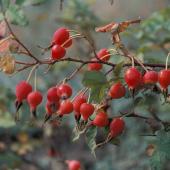Rose hips
Gwichya Gwich'in Name:
nichį̀h
Teetł’it Gwich’in Name::
nichih
Latin Name:
Rosa acicularis
As food
After the showy pink flowers bloom in June and July, the fruit develop into red berries called rose hips. The red berries are best picked and eaten when they are ripe in August and September. Remember to spit out the seeds before swallowing or you will quickly learn why rose hips are called “itchy bums!” Rose hips can also be fried and eaten. Boiled rose hips can be mashed and strained through a cheese cloth to remove the seeds. The strained juice can then be made into jam, jelly, or syrup. In early summer, green rose hips can be picked, boiled and strained to make a thickening agent, like Certo. Green rose hip juice can either be used immediately or stored in jars for later use.
As medicine
Rose hips are an excellent source of vitamin C and make a good cold remedy. Fresh rose hips can be eaten for relief from summer colds. For a winter supply, they can be dried, frozen, or boiled and strained to make a juice that can be stored in jars. Annie Norbert was told by Louis Cardinal that rose hips are good for the heart. Laura Pascal (COPE) used boiled petals for heat rash and cuts.
Source: Andre, Alestine and Alan Fehr, Gwich'in Ethnobotany, 2nd ed. (2002)
Storing BerriesThey kept berries in birch baskets. When they picked berries they wanted to keep them. They got birch and made it into a basket by sewing it with skinny willow bark from along the shore. After it was finished they put berries in it and made a lid and sewed it on. After that they dug a hole in the ground under moss where there was permafrost. They covered it and in the fall time, when it froze, they dug it up.- Mary Francis (COPE, d)



